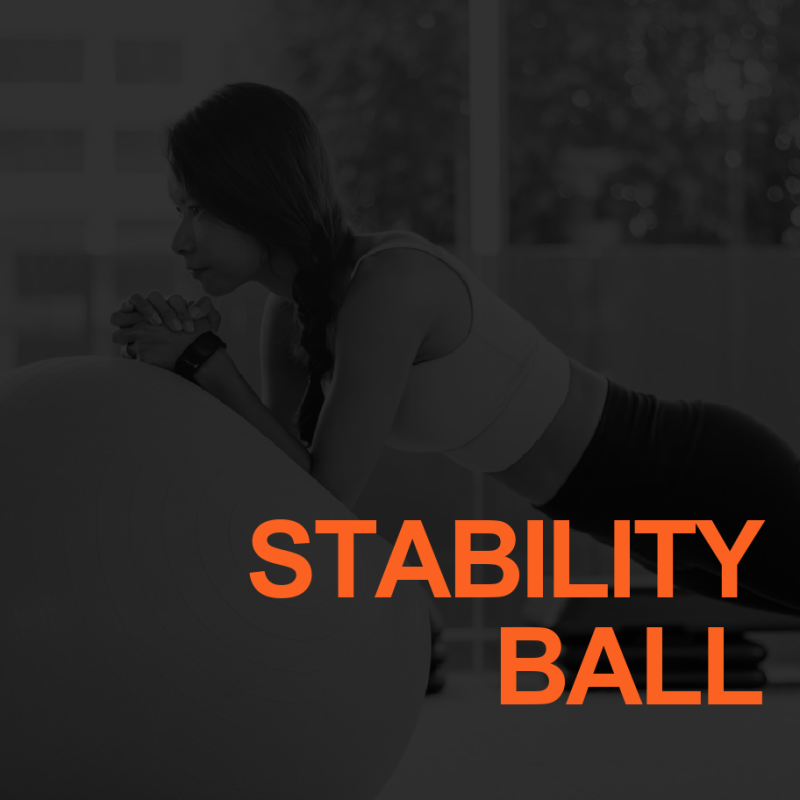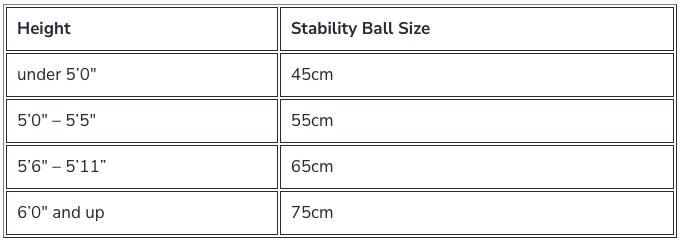
The stability ball, also known as a Swiss ball, physio ball, balance ball, or even Yoga ball, is a versatile piece of exercise equipment. While most gyms have a supply of them, it’s handy to have one at home. To be sure clients purchase the right type, there are a few things trainers can mention to help with the purchasing decision.
Buying Considerations
Some balls are made with sand instead to stabilize with the extra weight and be less likely to roll. The added weight is usually around 2.5 pounds– a plus for strength training exercises. Those without sand can still have sand added to them, albeit a tricky endeavor.
The balls come in different sizes with 45 cm typically recommended for shorter clients and up to 85 cm for the tallest. Some have weight limitations as well. Opinions vary on this, so check packaging to ensure the right size for clients. Below is a chart that most manufacturers adhere to.

Height and weight are the main considerations to make sure the ball fits appropriately. It’s not a one-size-fits-all. Many are color-coded to differentiate sizes, but that depends on the manufacturer. A general rule of thumb is that when seated on the ball, the knees should go directly out in front (not lower or higher than the ball) with the feet flat on the floor. In addition, most balls are capable of withstanding 250 to 300 pounds of pressure, so bear that in mind when working with or advising clients.
Hand/foot pumps are often included with the balls, usually providing their own variety of workout to inflate! If not, clients will need an air pump to inflate the ball. Depending on the amount of usage, the balls need to be checked periodically to ensure they are properly inflated. Inflation percentages also vary based on the manufacturer, so check packaging for instructions. As the ball deflates, there is less support.
Exercises
Once your client has their stability ball, there are lots of exercises to show them how to use them. As always, proper form is key to effective movement with minimal to no risk of injury.
The balls can be used to work abs, core, legs and just about everything else. Here are 12 exercise ideas to incorporate in training sessions or for workouts in-between training:
- Pass-throughs – lying supine pass the ball from between the feet to the hands and back, stabilizing the core
- Rollouts – knees on the ground and forearms on the ball as the ball is rolled forward and back again to engage the core
- Crunches
- Planks with lower legs on balls (add lateral toe taps for more challenge)
- Planks with forearms on ball
- Wall-sits with ball behind the back
- Bridge variations (back on the ball, feet on the floor; feet on the ball, back on the floor)
- Seated leg raises and knee lifts (can also be done on the ball in prone position with reverse raises)
- Bicep curls, hammers, and overhead presses while seated on the ball
- Jackknife (Push up position, hands on floor, feet on ball, piking the hips up and down)
- Push-ups with lower body on the ball
- Kneeling or standing twists/chops holding the ball
Other Uses
Stability balls are popular in many work settings. They can be used as a replacement for office chairs to reinforce balance, good posture, and core stability throughout the work shift. It’s also a good conversation starter!
Clients can do the same thing at home. Sitting on the ball while watching TV, talking on the phone, or working on the computer is another way to use the ball outside of working out.
With so much versatility, the balls are a viable option for most clients. This includes beginners to advanced. And prices are reasonable beginning as low as $15 for new ones.
References:
www.outsidebusinessjournal.com/brands/bosu-ballast-ball/
www.nytimes.com/wirecutter/reviews/best-exercise-ball/
www.womenshealthmag.com/fitness/a29417665/what-size-exercise-ball/
www.amazon.com/exercise-ball-stability-ball/b?ie=UTF8&node=3407921
www.youtube.com/watch?v=U3LWxSXwNX4


